The Great Trek
IN OCTOBER 1837 a party of 1,000 Whites, traveling in canvas-covered wagons drawn by teams of from 12 to 16 oxen, abandoned the rolling plains of the interior and began the difficult trek across the mountains to the inviting coastal lowlands. It was not the Rockies they were crossing, however, and they were not American pioneers: ten years before the discovery of gold in California gave such an impetus to the great migration westward across the American continent, White men and women were on the move northward in Africa.
The tall, fair, sturdy men who alternately cursed and cajoled their teams up the treacherous paths over the towering Drakensberg escarpment were Afrikaners, descendants of the Dutch and French Huguenot immigrants who had settled the South African Cape during the preceding two centuries. As the Afrikaners struggled through the difficult mountain passes, some of them had fleeting cause to regret leaving the familiar flatlands on the Cape Colony’s eastern frontier. But there was no turning back.
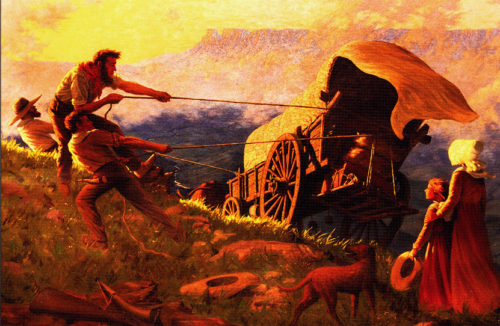
The Afrikaners trekking northward from the Cape Colony were farmers, or, as they proudly called themselves in their Dutch-based Afrikaans language, Boers. As tough and self-reliant as the American pioneers, they blazed a path across the trackless, arid veld and the forbidding mountain ranges of South Africa, defying numberless hordes of non-White savages to create a homeland where no civilized men had ever dwelt before. Perhaps even more so than their American cousins, the Afrikaners, in winning a new land, won a new identity.
The expedition which successfully traversed the Drakensberg and made its way into the fertile land of Natal was commanded by Piet Retief, who had been elected governor of all the Afrikaners moving northward just six months before. As Retief’s party advanced eastward across Natal toward the land of the Zulus, other Afrikaners continued to move northward across the veld toward the lands beyond the Vaal River, where, in contrast to Natal, the native Blacks were relatively few and disorganized. Despite their divergent destinations, all the migrating Afrikaners were united in a great, collective venture: they were the voortrekkers (“advance trekkers” or “pioneers”) who made the Great Trek into the heart of Africa.
To understand the Great Trek and the men and women who made it, some knowledge of the history and character of the Afrikaners is essential. The origins of White settlement in South Africa date back to 1652. In that year, five years after Pieter Stuyvesant was appointed governor of New Amsterdam (present-day New York), the Dutch East India Company established a resupply station at Table Bay, the site of the modern Capetown. There, company employees grew crops and raised livestock for the crews of the company’s ships engaged in the lucrative East Indian trade.
From the beginning, there was tension between the company officials who governed from Capetown (and, ultimately, from the Netherlands) and the Boer colonists who worked the land. The company’s governors saw the function of their African possession as purely economic—as just one component of the giant multinational corporation which provided Dutch burghers with ornate rugs and exotic spices, and the company’s stockholders with choice dividends.
The Boers, on the other hand, chafed at their inability to own their own farms and at the strict controls the company imposed on the marketing of their produce. Gradually, through the course of the eighteenth century, the Boers began to drift to the north and east, their ties to the authorities in Capetown growing progressively weaker.
From the beginning, the European farmers encountered non-Whites. On the one hand, the Boers employed slaves imported from the Dutch Malay possessions and other parts of Africa. More important, they came into contact with a variety of native non-Whites.
In the seventeenth and early eighteenth centuries, the Afrikaners concerned themselves chiefly with the Hottentots, a dwarfed, yellow-skinned race of pastoralists; and with the pygmy Bushmen, even more primitive, who subsisted by hunting and gathering their food in the South African deserts.
The Boers were able to domesticate the Hottentots and set them to useful labor, although their numbers were greatly reduced through disease. Miscegenation with imported non-White slaves, as well as with White indentured servants, gave rise to the mongrel “Cape Coloreds” of the present day.
The Bushmen had no redeeming values. They delighted in raiding the Boers’ herds of cattle and sheep, and the Boers in turn hunted down the predatory Bushmen mercilessly, all but annihilating them.
As the Boers moved further away from the western Cape, they began to brush against the advance guard of still another native race, the Negroid Bantus, who were simultaneously pressing westward and southward. Chiefly as a result of the thieving habits of the Kaffirs (as the Afrikaners referred to the Bantus), frequent wars broke out, in which the Whites always gained the upper hand. By the turn of the nineteenth century, the Afrikaners had advanced to the present eastern border of the Cape Province. Had it not been for a radical change in the political destinies of the Cape, their descendants might have remained there.
In 1806 Great Britain gained possession of the Cape, using the Netherlands’ enforced alliance with Napoleon as a pretext. The rigidly Tory governors Installed by the British Colonial Office were at pains to establish their authority over their wide-ranging Afrikaner subjects. To that end English was substituted for Afrikaans in the schools and the courts, and Afrikaner officials were replaced by Englishmen whenever possible.
More important, the British authorities began to undermine the existing relationship between the Afrikaner Whites and the African non-Whites. In this they were powerfully influenced by the Christian missionaries who had begun to stream into the country under the aegis of the London Missionary Society after 1806.
From the first, the men of the cloth espoused the cause of Hottentot and Bantu against their own White kinsmen. In 1812, the agitation of the Reverend J. R. E. Hall—who, from “religious principle,” had married a Hottentot woman—led to the institution of the infamous “Black Circuit,” by which English judges brought various Boers to task for their alleged mistreatment of their Hottentot slaves. Three years later an Afrikaner revolt arising from the investigation of similar charges led to the execution of five Boers for “treason.”
Over the next two decades the British Colonial Office continued to press for the integration of the Boers into the British administrative scheme of things, and the missionaries continued to intervene on behalf of the African non-Whites.
Matters came to a head in 1834, when the Boers were compelled to free their slaves (29 years before Lincoln’s Emancipation Proclamation) and then to accept a compensation far short of that which they had been promised.
During the same year, the results of the Sixth Kaffir War, in which Boer commandos had annexed a large portion of contested border land from the marauding Bantu Xhosas, were reversed by Lord Glenelg, the colonial governor. The British governor’s nullification of the Boers’ hard-won victory was due almost entirely to a pressure campaign by the London Missionary Society in England.
In response to a situation which was gradually becoming intolerable, as Hottentot laborers shirked their duties to the approbation of the clergy, and cattle-raiding Bantus marauded with near impunity, the Afrikaners began a number of tentative migrations to the north and east which gradually coalesced into the Great Trek.
The first small expeditions, undertaken in 1835, ended in complete failure. Jan van Rensburg’s small party was annihilated by Kaffirs on the high veld; and another group, led by Louis Trichardt, was decimated by malaria.
Over the course of the next two years, however, support for the Great Trek grew rapidly among the Boers in the frontier districts. In early 1837 Piet Retief, after issuing a manifesto justifying his course of action, set out from Grahamstown with his followers. After joining with an expedition led by Andries Hendrik Potgieter on the veld, Retief decided to strike east to Natal, despite the fact that the land was occupied to a large extent by the powerful Zulus, headed by the fierce and dictatorial Dingane.
After descending from the Drakensberg, the Afrikaners pitched their camps along the valley of the Blauwkrans River. There the bulk of the party stayed, while Retief and a picked detachment rode eastward to Dingane’s headquarters at the kraal of Umgungundlovu. Retief was sure that he could deal reasonably and fairly with the Black chief.
But at Umgungundlovu the Black chieftain was uncooperative. He accused Retief and his men of stealing a large herd of cattle and informed the Afrikaners that he would agree to nothing until the cattle were returned.
After several weeks searching, Retief and his men were able to locate the cattle and regain them from Sikonyela, a powerful rival of Dingane. On February 2 the Afrikaners returned in triumph to Umgungundlovu. Three days later Dingane signed a treaty which entitled Retief’s party to settle a vast expanse of fertile land on the coastal plain of Natal. After the signing of the agreement, the Zulus celebrated with riotous festivities, and the Boers gave an impressive demonstration of their prowess at riding and shooting.
On the following day, February 6, 1838, the White men were up before daybreak. As the Afrikaners readied their horses and equipment for the return to their families encamped along the Blauwkrans and a neighboring river, the Tugela, they could hear the pre-dawn stirrings in Umgungundlovu, a few hundred yards away. Now and again a chill breeze brought them distinct but incomprehensible snatches of the Zulu tongue and the pungent, unmistakable odor of thousands of Black men.
Piet Retief and the 70 Afrikaners he commanded were filled with a sense of satisfaction and relief as they prepared for their departure from Zululand. Secure in Retief’s hunting pouch was the all-important treaty which, at last, would enable the Boers and their families to end their months of anxious wandering and to resume their vocation as farmers.
Before the Afrikaners could ride off, a Zulu messenger approached. He brought word that Dingane desired the presence of Retief and his men at the royal kraal. There the two parties would toast their successful negotiations and their future friendship. The Whites agreed.
Retief and his party made their way across Umgungundlovu to the royal enclosure. They were bidden to stack their weapons outside the stockade, so as not to affront Dingane’s hospitality. They complied. Then the White men entered the headquarters of the Zulu king, and the gate was closed behind them.
Dingane greeted Retief from his crude wooden throne. Although the once-lithe Zulu warrior was now middle-aged and grossly fat, he radiated power and ruthlessness. As has all too often been the case with Negroes elevated to positions of authority, Dingane was capricious and unstable, and his whims often meant death for his subjects. Nevertheless, Retief trusted him, and the Afrikaners took and drank the strong sorghum beer offered them by the Zulus.
Drawn up around the Black ruler were two Zulu regiments, nearly a thousand men in all. At Dingane’s order, his soldiers began to dance. As the Black men writhed and undulated to the insistent rhythm of the drums, Dingane began to chant. The White men watched and listened, bemused and uncomprehending. And Dingane’s dark eyes watched the White men, those White wizards who killed men from afar and sped across the veld on horseback as if horse and rider were one.
The dance of the Zulus intensified, the warriors now surging forward, almost to where the Whites sat, now gliding back, with effortless grace. Suddenly Dingane sprang up and cried out: “Hither, my warriors! Cast yourselves upon them! Seize them! Hold them fast! Slay the wizards! Slay the wizards!”
At Dingane’s words the Zulus rushed forward and threw themselves on the unarmed Afrikaners. Outnumbered 10 to one, the Whites were quickly overpowered. A few were able to draw hunting knives and stab and slash at their Black assailants before they were seized. The rest shouted and struggled in vain.
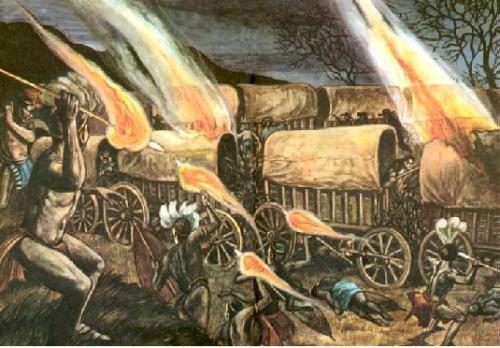
Some of the Afrikaners, particularly the young boys who had accompanied their fathers and older brothers to the Zulu capital, were strangled on the spot. The others were dragged forth from Umgungundlovu to the place the Zulus called Hlomo Amabuta, the hill of execution. There the blood-crazed Negroes finished their murderous work with spears and clubs.
Last to die was Piet Retief, who, arms pinioned, was forced to witness the slaughter of his White comrades and his teenaged son. When Retief was dead his heart and liver were ceremoniously presented to Dingane. The bodies of the Afrikaners were then left to carrion birds.
The Reverend Francis Owen, an English missionary, and members of his family were able to observe the massacre from their mission, which was situated on a hill overlooking Umgungundlovu. As with most of the White missionaries in Africa, Owen’s sense of racial kinship was inferior to his zeal to convert the non-White aborigines to Christianity. Although during the preceding few days Owen had sensed Dingane’s intentions, he had refrained from impressing Retief’s party with the gravity of the situation. Nor did this pious minion of the church make any effort after the massacre to warn the families of Retief and his men, camped only a few hours’ ride away. Several days later, he and his family fled to Port Natal, a British trading settlement on the coast.
No word of the fate of Piet Retief and his men reached the Afrikaners along the Blauwkrans and the Tugela for ten days. Then, on February 16, 1838, Dingane’s Zulu regiments struck with savage force against the remainder of Retief’s followers.
The Boers’ camps were small, scattered, and poorly defended. Infected by the same sense of false security which had led Retief and his men to their doom, they made easy targets for the 10,000-strong Zulu army which Dingane had dispatched from Umgungundlovu.
The Blacks began their attack at 1:00 A.M. on February 16. The small camp of the Liebenberg family was overrun and all of its inhabitants murdered, most of them as they slept.
Next the Zulus made their way to the Bezuidenhout wagons, several miles upstream. Daniel Peter Bezuidenhout saw his wife, mother, and sisters slaughtered by Dingane’s merciless troops. Although badly wounded himself, he was able to mount his horse and ride to warn the neighboring campsites.
The carnage was repeated at other encampments. Before the finally aroused Afrikaners were able to fend off the Zulus with their guns, the Blacks had claimed a fearful toll. In all nearly 300 Whites perished, including 41 men, 56 women, and 185 children. Entire families were wiped out.
The scenes illuminated by the first light of the rising sun almost defied description. Where the Zulu bands had triumphed, the grass was drenched with blood. Wagons and gear dripped gore. The bodies of the men and women, and those of the children as well, had been stabbed again and again with assegais, the short spears of the Zulus.
Johanna van der Merwe was found dead with 21 wounds, Catherina Prinsloo with 17. Elizabeth Smit lay dead, her breast hacked off, with her three-day-old baby dead beside her. Anna Elizabeth Steenkamp, one of the most resolute of the Boer women, described in her diary a wagon filled with 50 corpses, most of them children, drowned in their own blood.
The massacre at Umgungundlovu and the slaughter on the Blauwkrans threw the fate of the Afrikaners’ Great Trek into uncertainty. Despite further setbacks, including the defeat at Italeni of a Boer relief expedition commanded by Pieter Uys, costing Uys his life, the remaining members of Retief’s party never wavered. The Afrikaner women, above all, were adamant in refusing to abandon Natal. Through the grim winter months of 1838 the Boers held fast to their camps, while Dingane’s Zulus ravaged the British trading settlements on the coast.
At this critical juncture in South African history, Andries W. J. Pretorius, the greatest of the voortrekker leaders, rode north to take command of the Boers in Natal.
Pretorius, born in 1799, was the descendant of Germans who had migrated to the Netherlands and then to the Cape in the seventeenth century. A prosperous burgher who owned several farms in the Graaff-Reinet district of the frontier, he had not participated in the planning of the trek but, once his interest had been roused, had become an enthusiastic supporter.
Pretorius had made a preliminary visit to Retief’s encampment the previous December, and now, as the discouraging winter months wore on, he prepared to throw himself wholeheartedly into his people’s struggle. Selling his home, Pretorius Kloof in Graaff-Reinet, he rode to the north. In November 1838 the leaderless Boers elected him Commandant-General.
Within a week Pretorius had organized a force of more than 400 Boers. On November 28 he and his commandos moved off to the east. On the sixth day of their march the Afrikaners were met by a small force of Britons from Port Natal, anxious to settle their own accounts with the Zulus. Pushing north, the combined force made straight for Dingane’s capital at Umgungundlovu.
After six days of hard going through tall grass, skirmishing with Zulu patrols as they advanced, Pretorius’s force reached a river, called Ingome by the Zulus. There the Boers took up a strong position. The camp was covered on two sides by the river and by a tributary stream which flowed into the Ingome at an angle of roughly 45 degrees. The open end of the angle formed by the confluence of the two streams was defended by the Boers’ 64 wagons, massed end to end. Two cannons were situated at strategic points along the wagon wall.
At dawn on December 16, 1838, the Zulus attacked, advancing in regiments, each led by its commander, the younger men in the van, the veterans massed at the rear. As they moved forward, close to 10,000 of them, the Blacks sang and chanted in unison.
Pretorius had ordered his men to hold their fire until the Zulus were almost at the camp. Exercising iron self-control, the Boers waited until the Zulu battle line had advanced to within ten paces of their positions. Then the White men poured a merciless fire into the Black ranks. The Zulu line buckled and fell back several hundred yards.
Meanwhile, on the flanks, the Zulu troops attempted to cross the small stream and break in on the Boers from the rear. Swinging around one of their field pieces, the Afrikaners fired on the Blacks at short range with murderous effect, and the waters of the stream ran red with blood of the fallen Blacks.
Again the Zulus advanced from the front, and again they retreated before the deadly accuracy and rapidity of the Afrikaner musket and artillery fire. By now, hundreds of the Blacks had fallen.
Then Pretorius gave the order to attack. Leading a detachment of 150 men, he charged an advancing force of over 2,000 Zulus. By now dumb-struck with terror, the attacking Zulus veered to the left and raced toward the river, upstream from the Boer position. Hundreds waded in over their heads, desperately seeking cover from the White men’s guns, but to no avail. The Afrikaners fired point-blank at the Black men crowded in the water, and soon the river, like the stream, was dyed crimson with Zulu gore.
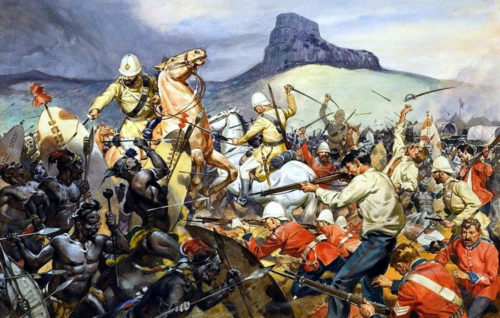
Pretorius, who was nicked by a Zulu assegai, and one other Boer were the only casualties the Boers suffered that day. A careful count of the Zulu dead totaled over 3,000. In the words of an Afrikaner witness, “the Kaffirs lay on the ground like pumpkins on a rich soil that has borne a plentiful crop.” The Boers pursued the fleeing Blacks until dark, exacting a fitting revenge for the massacres at Umgungundlovu and along the Blauwkrans.
The voortrekker victory at the Ingome—thenceforth known as Blood River—broke the power of the Zulus for decades. Two years later, fleeing another crushing defeat, Dingane was assassinated by one of his Black subjects.
Shortly after Blood River, Pretorius and his fellow voortrekkers established the Republic of Natal, in accordance with their concept of freedom and equality among White men. The Natal Republic, however, was short-lived. In 1843 the British landed a strong force at Port Natal, which defeated the Afrikaners within a month. Natal was then annexed to the Cape Colony.
The voortrekkers were undaunted by the seizure of Natal. Many of the men and women who had crossed the Drakensberg with Retief and Pretorius resumed their northward march. Joining the Afrikaners who had followed Potgieter and other leaders, they settled the territory which was to become the Transvaal Republic and the Orange Free State.
The history of these two republics was filled with vicissitudes and reversals for the remainder of the nineteenth century. During those years the Boers strove to maintain their way of life as a community of free White farmers, but the discovery of gold along the Witwatersrand in Transvaal led to inexorable pressure for British intervention on behalf of the rootless uitlanders, many of them Jews, who swarmed to the Transvaal goldfields in the 1880s and ’90s.
The story of the Boers’ gallant but hopeless fight against the mighty British Empire is well known. Less familiar, but equally inspiring, is the story of the Afrikaners’ successful struggle, over the course of the next 50 years, to maintain and strengthen their racial and cultural consciousness, a process which gradually resulted in the Afrikaners’ present control of the South African state.
The prerequisite for the outlook which underlay those years of struggle, indeed the prerequisite for an Afrikaner identity, was the experience and memory of the Great Trek. The Great Trek galvanized the discontented but disorganized Boers of the Cape frontier into a disciplined, self-aware, racial community. In the words of South African historian Gustav Proller, written of Piet Retief but equally applicable to the influence of the Great Trek, “It is Retief’s greatest virtue that in his deeds and in his death, he compelled the Dutch-Afrikaans emigrants to believe that they were not merely isolated, roaming individuals, but that everyone was a participant in a great national bond, with one concern and one destination.”
* * *
Source: National Vanguard tabloid, Issue No. 59, 1978; The Best of Attack! and National Vanguard Tabloid, ed. Kevin Alfred Strom (Arlington, VA: National Vanguard Books, 1984), pp. 117–19; transcribed by Anthony Collins


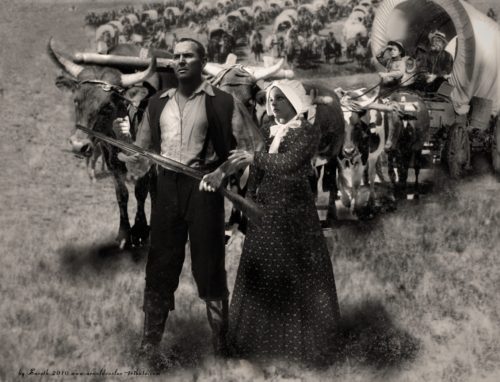

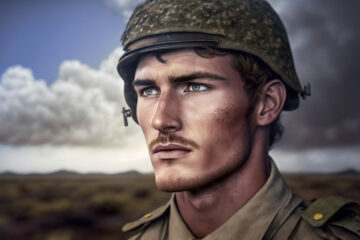


Do you know that you have a totally inaccurate picture illustrating the Zulu defeat at “Blood River” (1838)? The picture you have is in fact the “Battle of Islandwana” in 1879 where a large contingent of BRITISH SOLDIER (RED-COATS) were surprised and slaughtered by the Zulu at the base of the Hill known as Isandlwana.
We have corrected the caption — thank you.
Many thanks.
Do you have any information on who the artist was who painted the scene of the men pulling the wagon while the lady and the child watched?
I’ve always loved that one and a copy was hanging in an aunts sitting room in Wenen